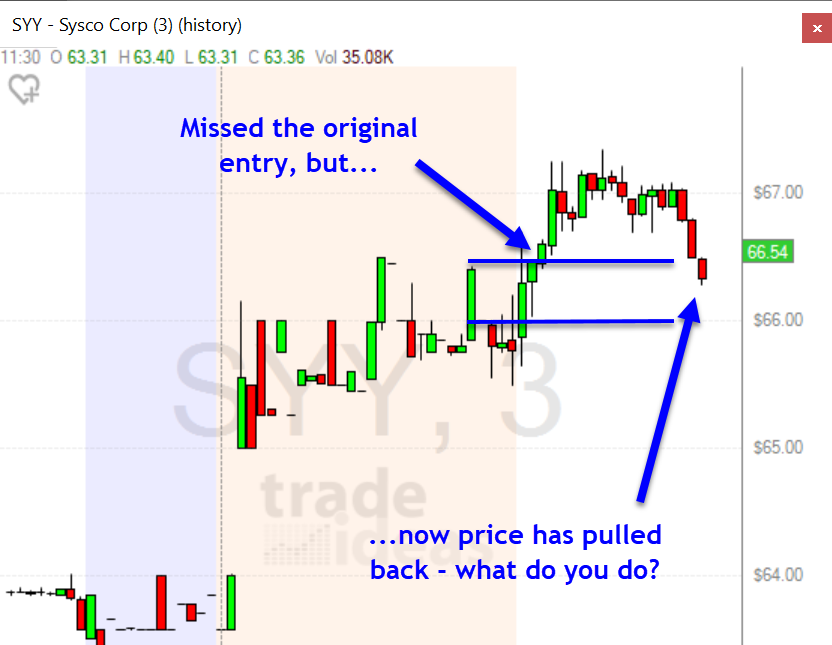One of the most frustrating things that can occur as a trader is when you miss a profitable trade. You’ve gone through countless hours of diligent work and research to create and refine a trading strategy, you’ve paper traded it, you’ve double checked that you crossed your Ts and dotted your Is, and maybe even weathered a drawdown. Finally another trade setup comes along and — dang! — you miss it by either being a moment too late or, even worse, you have your entry order in place and you don’t get filled and the price blows by.
The price is now well into what would have been profitable territory had you gotten in the trade, but now you’re left sitting on the sidelines wondering what might have been.
Like getting barely stopped out of a profitable trade, this can be very frustrating for a trader. This can also lead to another situation that most traders don’t put a lot of thought into.
Price Pulls Back to your Original Entry
So you missed the original trade, but now the price has pulled back offering you another shot. Do you take it? Here’s a hypothetical but very realistic example in SYY from 2/4/2019.
There are two conflicting ideas in this scenario.
- You are being offered a second chance to take the trade at the original or perhaps even a better price.
- However, if you take this trade you are guaranteed to take 100% of the trades that end up hitting your stop as this is exactly the behavior of trades that stop out.
These two ways of thinking about this scenario are of course in stark contrast to each other. What is the best way to think about this scenario so that you have a plan when this all too common situation arises? I see two answers to this question, one very simple and one more complicated but complete answer.
The Simple and Perfectly Valid Answer
Your default answer should be this: if you hadn’t missed the original entry, is there any reason you wouldn’t still be in this trade? If not, then you should take the second entry — after all, this is literally a second chance to execute your original plan for this trade.
This is a perfectly valid answer that gives you a stress-free way to respond to the situation. But…
The Difficult but More Rewarding Answer
The real crux of the situation is this: even if you establish that you would still be in the trade if you took the original entry, you now have more information than you had prior. Has the stock exhibited any behavior that makes it more likely to end up a profitable or losing trade? If so, that should play heavily into your decision about whether to take this second entry.
This leads us to a discussion of my favorite and commonly neglected trading topic: post-entry trade analysis. Every trader spends a lot of time thinking about pre-entry analysis, but very few spend the time required for the more rewarding topic: what happens after you enter your trades.
Post Trade Analysis — Where to Begin
To start making a plan for our situation in SYY, we need to figure out where to focus. The first thing to do is review the charts for the trades you’ve taken. Focus on the trades that went in your direction initially like SYY. Separate these charts into profitable trades and losing trades. Is there some behavior that some of the winning trades exhibited that some of the losing trades didn’t? If so, try to formulate a rule and keep score using a spreadsheet for as many previous trades as you can. As with any sort of analysis, it’s the aggregate that counts — any one particular trade in and of itself is meaningless.
This can be especially difficult since these are trades that you’ve taken and probably have some memory of (hindsight bias). Try to leave this emotional baggage at the door. As much as possible take on the role of a skeptical, neutral observer.
If you find a characteristic that shows promise it can have a dramatic effect on your results. We’re only discussing this missed trade scenario, but think about what this implies. If you can determine a statistically sound rule to use for this scenario, you can also apply it to different ones. For example, if you’re already in a trade that exhibits profitable behavior and then pulls back as SYY did, you can use this information to scale in and add to your position. Conversely, if it shows negative behavior you could exit your existing position at breakeven and avoid a loss entirely. This is hugely powerful information that can substantially raise your system’s profitability — and not by adding more trades, but by simply altering the trades you’re already making! As I alluded to in my post on scaling into trades, this is very difficult by has the potential to be highly rewarding.


1 comment